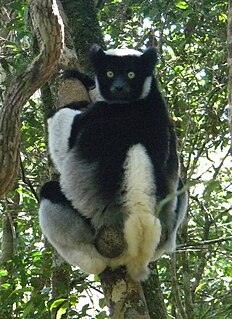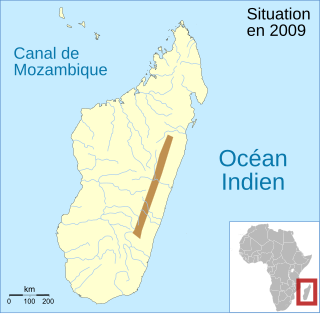
The cuckoo-roller or courol is the only bird in the family Leptosomidae, which was previously often placed in the order Coraciiformes but is now placed in its own order Leptosomiformes. The cuckoo-roller is at the root of a group that contains the Trogoniformes, Bucerotiformes, Piciformes, and Coraciiformes.

The Madagascar lowland forests or Madagascar humid forests are a tropical moist broadleaf forest ecoregion found on the eastern coast of the island of Madagascar, home to a plant and animal mix that is 80 to 90% endemic, with the forests of the eastern plain being a particularly important location of this endemism. They are included in the Global 200 list of outstanding ecoregions.

Ravenala is a genus of monocotyledonous flowering plants. Classically, the genus was considered to include a single species, Ravenala madagascariensis, commonly known as the traveller's tree, traveller's palm or East-West palm, from Madagascar. It is not a true palm but a member of the family Strelitziaceae. The genus is closely related to the southern African genus Strelitzia and the South American genus Phenakospermum. Some older classifications include these genera in the banana family (Musaceae). Although it is usually considered to be a single species, four different forms have been distinguished. Five other species were described in 2021, all from Madagascar: Ravenala agatheae Haev. & Razanats., R. blancii Haev., V.Jeannoda & A.Hladik, R. grandis Haev., Razanats, A.Hladik & P.Blanc, R. hladikorum Haev., Razanats., V. Jeannoda & P.Blanc, R. madagascariensis Sonn., et R. menahirana Haev. & Razanats.

Adansonia madagascariensis or Madagascar baobab is a small to large deciduous tree in the family Malvaceae. It is one of six species of baobab endemic to Madagascar, where it occurs in the Madagascar dry deciduous forests.

Platypelis tsaratananaensis is a species of frog in the family Microhylidae.

The Madagascar cuckoo-hawk, also known as the Madagascar baza or the Madagascan cuckoo falcon, is a species of bird of prey in the family Accipitridae. It is endemic to Madagascar.

The Malagasy bulbul is a species of songbird in the bulbul family, Pycnonotidae. It is found on Madagascar and other regional islands in the south-western Indian Ocean.

The Madagascar pygmy kingfisher is a species of bird in the family Alcedinidae. It is endemic to Madagascar and found in western dry deciduous forests.

The Madagascar rail is a species of bird in the family Rallidae.

The Madagascan rousette or Madagascar rousette, is a species of megabat in the family Pteropodidae endemic to Madagascar. Its natural habitat is subtropical or tropical dry forests. It is threatened by habitat loss.
The Ankeniheny-Zahamena Corridor (CAZ) is a large area of protected forest biome in eastern Madagascar. The CAZ encompasses some 3,810 km2, making it one of the largest areas of rainforest remaining in the country. Over 2,000 species of plants have been recorded in the CAZ, nearly 1,700 of which are endemic to the region.

Beccariophoenix madagascariensis, commonly known as the coastal beccariophoenix, is a species of flowering plant in the family Arecaceae. It is a large Coconut relative that is vulnerable in its habitat in Madagascar.

The western lesser bamboo lemur, also known as the northern bamboo lemur, western gentle lemur, or Sambirano lesser bamboo lemur, is a species of bamboo lemur endemic to Madagascar.

Zahamena National Park is a national park of Madagascar. Established in 1997, it covers an area of 423 square kilometres (163.32 sq mi) out of a total protected area of 643 square kilometres (248.26 sq mi). It is part of a UNESCO World Heritage Site, Rainforests of the Atsinanana, inscribed in 2007 and consisting of 13 specific areas located within eight national parks in the eastern part of Madagascar. In 2001, Bird Life International assessed avifauna of 112 species of which 67 species are exclusively endemic to Madagascar.
Mangerivola Special Reserve is a wildlife reserve in the east of Madagascar. It was established in 1958 and is a hotspot for bird-watchers due to the one hundred species found there, including 63 endemics and many local endemics. There are also seven species of lemur and rare chameleons such as the Lance-nosed chameleon which is registered as endangered on the IUCN Red List of Threatened Species.

Langaha madagascariensis is a medium-sized highly cryptic arboreal species. It is endemic to Madagascar and found in deciduous dry forests and rain forests, often in vegetation 1.5 to 2 meters above the ground.

Paroedura masobe is an endangered species of reptile. This species is endemic to Madagascar, where it is known from low elevation sites in the north of the Ankeniheny-Zahamena Corridor. The extent of occurrence is currently 410 km2 (160 sq mi), however, due to the scarcity of suitable habitat between the known sites its true distributional extent within this area is likely to be below 100 square kilometres (39 sq mi). It occurs from 300 to 600 metres. The animal likes the habitats in low elevation and humid forests.

Rhombophryne coronata is a frog of the family Microhylidae. It is endemic to eastern Madagascar.
Chapelieria is a monotypic genus of flowering plants in the family Rubiaceae. The genus contains only one species, viz. Chapelieria madagascariensis, which is endemic to Madagascar.

Uapaca bojeri, or tapia, is a tree species endemic to Madagascar. A characteristic element of the Madagascan flora, it occurs in the central highlands, where it dominates a type of sclerophyllous forest or woodland. Tapia forest has a high ecological value due to the fauna and flora it harbours, and is of economic interest to the local population, e.g. for collection of tapia fruits, firewood, mushrooms or wild silkworms, and hunting. Local impact through fire and cutting is seen as a form of sustainable use however tapia woodlands are now found only in scattered, isolated stands totaling at most 132,255 ha. Native woody vegetation of the central highlands is increasingly replaced by grasslands, primarily due to increased fire frequency as areas are burned annually.

















